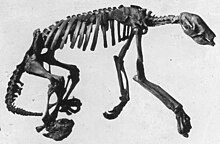| Nothrotheriidae Temporal range: Early Miocene – Early Holocene (Irvingtonian-Rancholabrean (NALMA) & Santacrucian-Lujanian) (SALMA)
~ | |
|---|---|

| |
| Shasta ground sloth (Nothrotheriops shastense), Peabody Museum | |
| Scientific classification | |
| Domain: | Eukaryota |
| Kingdom: | Animalia |
| Phylum: | Chordata |
| Class: | Mammalia |
| Order: | Pilosa |
| Clade: | †Megatheria |
| Family: | †Nothrotheriidae (Ameghino 1920) C. de Muizon et al. 2004 |
| Genera | |
| |
Nothrotheriidae is a family of extinct ground sloths that lived from approximately 17.5 mya—10,000 years ago, existing for approximately 17.49 million years.[7] Previously placed within the tribe Nothrotheriini or subfamily Nothrotheriinae within Megatheriidae, they are now usually placed in their own family, Nothrotheriidae.[8] Nothrotheriids appeared in the Burdigalian, some 19.8 million years ago, in South America. The group includes the comparatively slightly built Nothrotheriops, which reached a length of about 2.75 metres (9.0 ft). While nothrotheriids were small compared to some of their megatheriid relatives, their claws provided an effective defense against predators, like those of larger anteaters today.
- ^ Cite error: The named reference
Amsonetal2017was invoked but never defined (see the help page). - ^ Varela, L.; Tambusso, P.S.; McDonald, H.G.; Fariña, R.A.; Fieldman, M. (2019). "Phylogeny, Macroevolutionary Trends and Historical Biogeography of Sloths: Insights From a Bayesian Morphological Clock Analysis". Systematic Biology. 68 (2): 204–218. doi:10.1093/sysbio/syy058. PMID 30239971.
- ^ A 2017 phylogenetic study moves this subfamily to Megatheriidae,[1] while a 2019 study retains it in Nothrotheriidae.[2]
- ^ PUJOS, FRANçOIS; DE IULIIS, GERARDO; MAMANI QUISPE, BERNARDINO; ADNET, SYLVAIN; ANDRADE FLORES, RUBEN; BILLET, GUILLAUME; FERNáNDEZ-MONESCILLO, MARCOS; MARIVAUX, LAURENT; MüNCH, PHILIPPE; PRáMPARO, MERCEDES B.; ANTOINE, PIERRE-OLIVIER (2016-11-01). "A new nothrotheriid xenarthran from the early Pliocene of Pomata-Ayte (Bolivia): new insights into the caniniform-molariform transition in sloths". Zoological Journal of the Linnean Society. 178 (3): 679–712. doi:10.1111/zoj.12429. hdl:11336/182949. ISSN 0024-4082.
- ^ François Pujos, Gerardo De Iuliis, Bernardino Mamani Quispe & Ruben Andrade Flores (2014) Lakukullus anatisrostratus, gen. et sp. nov., a new massive nothrotheriid sloth (Xenarthra, Pilosa) from the middle Miocene of Bolivia,Journal of Vertebrate Paleontology, 34:5,1243-1248, DOI: 10.1080/02724634.2014.849716
- ^ Gaudin, T. J.; Boscaini, A.; Mamani Quispe, B.; Andrade Flores, R.; Fernández-Monescillo, M.; Marivaux, L.; Antoine, P.-O.; Münch, P.; Pujos, F. (2022). "Recognition of a new nothrotheriid genus (Mammalia, Folivora) from the early late Miocene of Achiri (Bolivia) and the taxonomic status of the genus Xyophorus" (PDF). Historical Biology: An International Journal of Paleobiology. 35 (6): 1041–1051. doi:10.1080/08912963.2022.2075744. S2CID 258688117.
- ^ PaleoBiology Database: Nothrotheriidae, basic info
- ^ Muizon, C. de; McDonald, H. G.; Salas, R.; Urbina, M. (June 2004). "The Youngest Species of the Aquatic Sloth Thalassocnus and a Reassessment of the Relationships of the Nothrothere Sloths (Mammalia: Xenarthra)". Journal of Vertebrate Paleontology. 24 (2). Society of Vertebrate Paleontology: 387–397. Bibcode:2004JVPal..24..387D. doi:10.1671/2429a. S2CID 83732878.